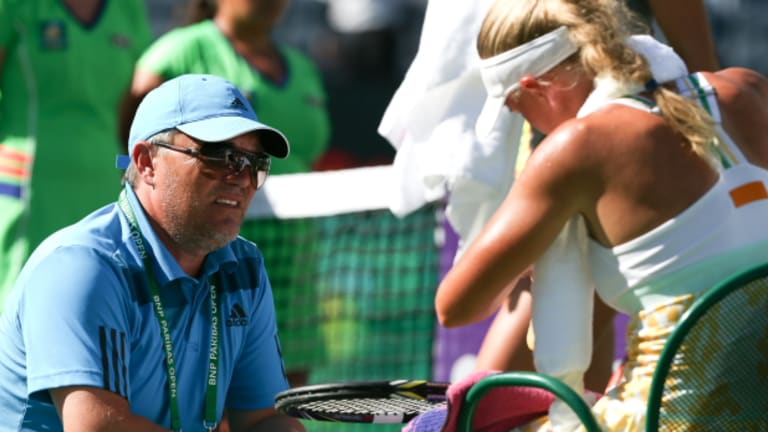INDIAN WELLS, CALIF.—“Obviously he’s been on the road for a long time,” Sloane Stephens toldwtatennis.com this week, when she was asked about her new mentor, Paul Annacone. “He’s also coached Pete Sampras and Tim Henman.
Way to make a guy feel young, Sloane. It’s true, though, Annacone’s work with Pistol Pete and Tiger Tim is pretty last century. Sampras had already won a Grand Slam title by the time Stephens, who will celebrate her 21st birthday on March 20th, was born. That, incidentally, is the same day that Annacone will turn 51.
While they’re both Pisces, and they both live in Los Angeles, Annacone and Stephens do make for an unlikely duo. That’s not because, as Sloane implies, he has descended from the tennis heavens to work with a mere mortal; Stephens might not be Roger Federer, but she’s a potential Grand Slam champion in her own right. Rather, the reason it seems odd to me is that the two of them appear to be the ultimate odd couple, the California generation gap personified. Sarcastic Sloane is a wisecracking, prematurely world-weary post-teen. Placid Paul, father of two, has the unshakably mellow self-assurance of a New Age motivational speaker. Here are two sample quotes from their interviews with the WTA:
Annacone, on the similarities between the men’s and women’s games these days: “The women’s game is getting much more athletic as well, and it’s interesting to see how the women use their athleticism to suit their skills. It’s still a tennis court, it’s still a game, and it’s still about maximizing your potential, but mostly it’s about maximizing your average days and dealing with adversity and not letting that affect your self-belief, happiness, or goals.”
And remember, he didn’t write that, he said that.
Here’s Sloane, on Annacone: “So Paul coached Roger, and now he’s my coach, and that’s crazy.”
Last month, the partnership began to move from the strange to the mysterious. When Annacone skipped Stephens’ February tour of Doha and Dubai, spending his weekends commentating on the Tennis Channel instead, she was asked more than once if the two of them were still working together. And if they were, was he the right coach for her? Annacone had spent his career guiding already established stars, ultimate professionals at the peaks of their powers; he kept the high-achievers achieving. It seemed to me that Stephens, prone to passive play and post-adolescent funks, and nowhere near her having reached her potential, could do with a little tough love. Tougher than what Annacone would normally bring.
Last night Annacone was in Sloane’s corner for her opening-round match at Indian Wells. The scene was ominously similar to her opener here last year, when she lost a late-night match to Urszula Radwanska in an empty arena. This time it was also late, and the place was nearly as empty; after Rafael Nadal’s galvanizing win over Radek Stepanek, the fans had nothing left for Sloane, and most of them bolted. It had all the makings of a perfunctory performance from the American. The woman Stephens was playing was 20-year-old Ajla Tomljanovic, who had nearly knocked her out at the Australian Open in January.
So what do you know? Stephens played the best match I’ve seen from her, and that includes her win over Serena Williams in Melbourne last year. She won 6-4, 6-0, and attacked the ball on the rise throughout. Most impressive was the way she began the second set. Tomljanovic had mulitple game points on her serve at 0-0; with the first set in hand, it would have been easy, or at least natural, for Sloane to let this game go. But she fought tooth and nail for each of those points, and when she finally broke serve, she broke Tomljanovic’s spirit with it.
That was just one match, obviously. But it was probably Stephens’ best match of 2014, and she played exactly the way most of us have thought she could, and should, play. She and Annacone will always speak different languages, and they may not last that long if things don’t go well early. But there could also be a similar dynamic to the one that has been so successful for Andy Murray and Ivan Lendl. Stephens, by virtue of Annacone’s track record alone—his "long time on the road"—has to respect him, and should want to play well for him, for both of their reputation’s sakes. That’s not so odd, is it?
